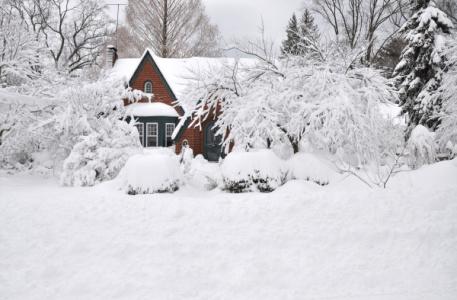
18 WAYS TO WINTERIZE YOUR HOME
At this time of the year, you may wake up to colder temperatures and trade your sandals for sweaters. However, your house also needs help preparing for the changing seasons, especially if you live in an area where the temps can plummet and the snow can pile up.
Get a jump on winter weather by taking these steps to safeguard your home.
Pack up summer yard essentials.
Many of the items that you use outdoors over the summer can be damaged by freezing temperatures, snow, and ice if they aren’t protected in advance:
1. Lawnmower - Leave the tank empty the last time you mow.
2. Patio furniture - Move fabric seat cushions and pillows indoors or into a shed and cover your table, chairs, and sofa with protective tarps.
3. Grill - Turn off and disconnect the gas line, then clean and cover your grill.
4. Rain barrel - Disconnect any rain barrels and store them sideways or upside down, so water doesn’t collect and freeze.
5. Garden hoses - Disconnect hoses from the spigot, drain any remaining water, and store them.
Eliminate drafts.
Airtight homes feel more comfortable and cost less to heat. Check these common sources of drafts and energy leaks:
6. Windows - There are numerous ways to make your windows more energy efficient and eliminate drafts, including weather stripping, window films, rope caulk, and window coverings.
7. Doors - Ensure the weather stripping is intact around the perimeter of any exterior doors, especially along the threshold.
8. Electrical boxes - Remove the covers from any switches and outlets on the exterior walls of your home and see if there are gaps around the electrical boxes that can be filled with insulating foam. Also, consider adding inexpensive foam gaskets behind the cover plates.
9. Fireplace - If you have a fireplace, keep the damper closed when the fireplace is not in use. And if you don’t plan to use the fireplace at all, consider installing a fireplace plug that fits snuggly against the damper or a heavy fireplace blanket.
Protect your pipes.
Frozen pipes can burst and cause substantial damage. Take these steps to protect your pipes.
10. Insulation - If you have pipes exposed to colder temperatures, like a garage or a basement, you can add various types of foam, rubber, fiberglass, or wrapped insulation to reduce their exposure to freezing temps.
11. Shut-off valves - In addition to disconnecting garden hoses, consider adding an interior shut-off valve to the water line supplying your spigots. Then, you can turn off the water line within the heated space of your home, open the exterior faucet, and drain any remaining water that may be vulnerable to freezing.
12. During extreme cold - You can take additional temporary steps to protect any of your indoor plumping that runs along exterior walls. For example, leave sink cabinet doors open so more warm air reaches the pipes. You can also set the faucet to a slow drip, so water continues flowing.
Prevent ice dams.
Ice dams are a ridge of ice that can form where the roofline meets the gutters, potentially causing water to back up and enter your home.
13. Clean gutters and downspouts - As soon as the last leaves have fallen, ensure no remaining debris can restrict water flow through your gutters and downspouts.
14. Check shingles and flashing - Make sure your shingles and flashing are intact, so it’s harder for water to seep under them.
15. Add attic insulation - You can lessen the likelihood of ice dams forming by reducing the heat that escapes into your attic and warms the underside of your roof.
Additional steps.
16. HVAC system - Schedule a professional furnace inspection each fall to ensure your unit is ready to keep you warm when the coldest weather arrives. Also, this is probably a good time to change the filter.
17. Ceiling fans - If you have ceiling fans, reverse the direction of the blades so that warm air trapped on the ceiling will gently circulate downward along the walls.
18. Snow removal equipment - Pull together everything you’ll need to tackle the first snowfall, including shovels and de-icing agents. If you own a snowblower, ensure it’s gassed up and ready to use!

Leave A Comment